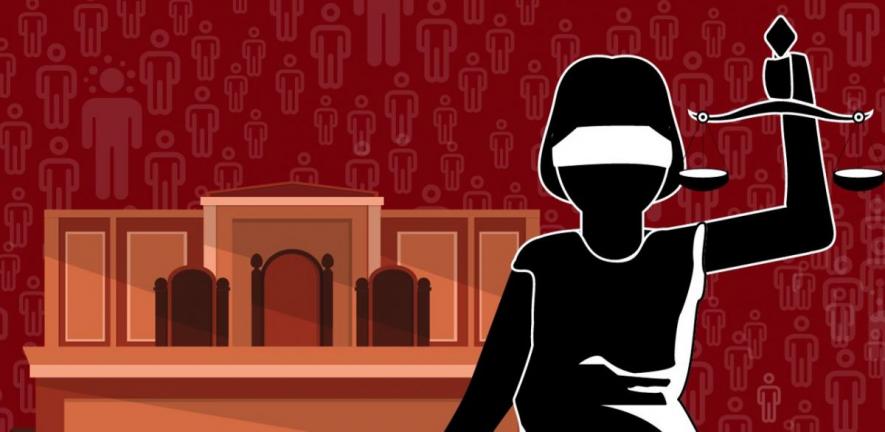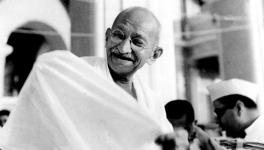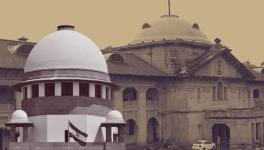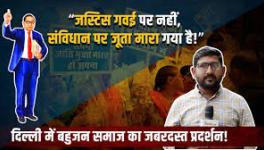2023: The Year of the Surajmukhi Court

Representational Image.
As 2023 continues the backslide of democracy in India, what role has the judiciary played in it, and what role could it play? Indira Jaising cuts through the dense fog.
—
At the end of the year, a court must be judged by its core function, the judgments that it delivers in defense of the rights of citizens and the defense of the rule of law, holding power to account.
Constitutions have existed under monarchies and kings who claim a divine right to rule. There is no concept of kings being accountable to the people, they are accountable only to the Divine.
However, modern constitutions are based on the theory that sovereignty resides with the people to be exercised in our interest by our elected representatives. They bear distinctive features that encode liberal norms and most importantly mandate their enforcement by a judiciary.
Our Constitution is a binding legal document not a statement of political intent to be enforced at the discretion of the government of the day.
Constitutions have existed under monarchies and kings who claim a divine right to rule. There is no concept of kings being accountable to the people, they are accountable only to the Divine.
Marbury versus Madison, decided in 1803 in the US, established judicial review, which laid the foundation for modern-day constitutional and administrative law. The judgment came at a time when the Supreme Court of the US was being attacked by Thomas Jefferson and his followers.
The judgment of Justice Marshall established for the Supreme Court of the United States the apex position of final interpreter of the Constitution. There is little disagreement among scholars around the world on the principle that “a law repugnant to the Constitution is void, and that courts, as well as other departments, are bound by that instrument”.
This is what constitutionalism is about. That was the end of the doctrine of supremacy of the Parliament or the Congress, by giving the court a final voice on the legal and constitutional propriety of acts of any member of the Executive or an Act of Congress.
Ours is a Constitution that explicitly states, in Article 13, that all laws, customs, and usages inconsistent with or repugnant to our fundamental rights shall to the extent of the repugnancy be void.
The very existence of Articles 32 and 226, which allow direct access to the Supreme Court and the High Courts respectively, establishes the enforceability of our rights.
There is a hierarchy of norms for the governance of our society and the Constitution is at the top of it.
Yet our Constitutional rights as citizens now appear to be unenforceable. Our elected representatives now treat the Constitution not as a normative and enforceable document but as a political document alone, a statement of intent to be enforced selectively at its discretion.
Our Constitution is a binding legal document not a statement of political intent to be enforced at the discretion of the government of the day.
It is this approach to the Constitution that the court has been unable to correct and on which it has failed to demand accountability.
In 2023, the Supreme Court failed to protect electoral democracy, the health of our economy, our own health, federalism, and the fundamental rights of citizens.
Whether it was demonetisation and its impact on the country, the right of our elected representatives to remain in office without being subjected to Operation Lotus, or the disappearance of a state and its conversion to a Union territory, the court deferred to the wisdom of the government of the day, sometimes explicitly stating that it was not the function of the court to interfere with government policy or under the doctrine of not wanting to enter the “political thicket” laying claim to work on the theory of separation of powers.
Gradual repudiation by the court of its core function of judicial review
It appears almost as if our rights are not enforceable anymore and there is an attempt to return to the idea that governments are benevolent decision-makers and know best what to do. The Constitution has been robbed not only of its spirit but also of its binding normative nature.
The government of India has not lost a single judgment in the Supreme Court this year
The four most significant challenges to major decisions of the government, demonetisation (save for one dissent), the swearing in of a Bharatiya Janata Party (BJP)-led government in Maharashtra by the governor, the abolition of Article 370, and the challenge to the Special Marriage Act, 1954 which excludes queer marriage, all were decided in favour of the government.
A prominent feature of judgments of the Supreme Court this year has been that even when the declaration of law was in favour of the petitioner, the operative Order was not.
The court in Subhash Desai versus Principal Secretary, Governor of Maharashtra and Ors held that the action of the governor in swearing in a new government was bad in law and yet the government was allowed to remain in place, and it was left to the speaker to decide on the applications for disqualification of members of legislative assembly (MLAs).
At the time of writing, more than one year after the chief minister was unlawfully sworn in, the BJP remains the ruling party and the speaker has taken no decision.
Ours is a Constitution that explicitly states, in Article 13, that all laws, customs, and usages inconsistent with or repugnant to our fundamental rights shall to the extent of the repugnancy be void.
When it came to In Re Article 370 of the Constitution of India, even though the Supreme Court held that the amendment to Article 370 proviso via the Article 367 rout was ultra vires, it ruled that the abolition of Article 370 by the Presidential Order was valid since the President could, in any event, abolish Article 370 by resorting to Article 307(3) independent of the proviso “unilaterally”.
The entire discussion of the powers of the President during an Emergency was unnecessary, the abolition could occur with or without an Emergency. On the question of the validity of the reorganisation of the state into a Union territory, the court accepted the statement of the Solicitor General of India— which is not binding on the Parliament— that elections in J&K will be called before September 2024, rather than giving a mandamus to conduct the elections.
When it came to same-sex marriage, the court sent the petitioners back to the government to work out a new law laying down guidelines for a violence-free relationship.
The ruling party believes that our jurisprudence can be written and rewritten, and that it is time to return to our culture which goes back to Vedic times— to a time before repeated invasions by ‘foreigners’.
They believe that our laws are to be found in the Manusmriti and the Arthashastra and we must return to our roots. Could these ideas perhaps be permeating into the judiciary through a process of osmosis?
If the Constitution of India has any value, it is that it contains Article 226 and Article 32 which enable the courts to give binding directions to the government, which are the heart and soul of the Constitution. It is these Articles that are endangered today.
The body of the judiciary has self-inflicted wounds.
The question
How has all this been achieved?
Some authors such as Tarunabh Khaitan have expressed the view that this has been achieved by killing the Constitution with a thousand cuts. True that is for the legislature. But what about the judiciary?
Others have said that when governments are authoritarian and majoritarian, the courts are weak. But then why have an independent judiciary at all?
Still others call it an ‘Executive court’, an inaccurate description since Executive courts do not normally have the power of judicial review at all, as in the former USSR.
Some have even suggested that the courts are being blackmailed. For this, there can be no evidence.
The answer can be a combination of these factors but there is something deeper than these factors to be investigated.
To understand this, let us look at our not-too-distant constitutional past, the declaration of the Emergency and the resistance to it.
There is a hierarchy of norms for the governance of our society and the Constitution is at the top of it.
The struggle against the Emergency demonstrated both the strength and the malleability of constitutionalism. It demonstrated how the political process, parties and individuals approach a written document, namely the Constitution, to shape their approach and attitude to the rule of law.
The struggle against the Emergency was to restore the status quo ante politically and later to amend the Constitution to ensure that the right to life is guaranteed and can never be suspended.
Both, Indira Gandhi, who was instrumental in imposing the Emergency, and Jayprakash Narayan, who led the struggle to revoke the Emergency, accused each other of being “dictators” and “fascists”— meaning thereby they saw the other deviating from the path of liberal democratic principles on which the Constitution and Indian polity was envisioned to be founded.
Both of them claimed allegiance to the Constitution. Speaking of the events which led to the imposition of the Emergency, namely the protests led by Jayprakash Narayan and the students’ movements, Bipan Chandra points out in his book In the Name of Democracy: “The defence of Indian democracy seems to have been the main justification for both the J.P. movement and the Emergency regime.”
In the hierarchy of norms for the governance of our society, both accepted that the Constitution is at the top.
In contrast, today’s ruling party looks at liberalism as an import, they yearn for a return to Ram Rajya, the codes of Manusmriti and the governance of the Arthashastra.
Sitting judges now refer to these texts to justify their decisions at a rate that can only be described as alarming. Theology, whatever name is used to refer to it— custom, culture or religion— has for many become the source of law.
This change is symbolised in our public life by the installation of the Sengol in the new Parliament building, a symbol of kingship rather than of Republicanism.
With the upcoming consecration of the Ram Temple— built by a trust set up by a Supreme Court judgment— by constitutional functionaries in the name of exercising the right to religion, the separation between religion and the State is imploding. What tsunamis this admixture will produce only time will tell.
The question also is how this appeal to customs and culture impacted the judiciary.
It appears to have had a direct impact on the judiciary as they too have started appealing to culture and customs to justify imposing restrictions on fundamental rights or writing them out of existence.
Nothing illustrates this better than the judgment of Justice Narasimha in the marriage equality case (see Part 2).
The judgment shows that, mirroring the Executive, our courts have set up a norm above the norm of the Constitution, i.e., culture, and will not enforce the text of the Constitution when it conflicts with the culture, howsoever defined. It is indeed the repudiation of the judicial function.
In 2023, the Supreme Court failed to protect electoral democracy, the health of our economy, our own health, federalism, and the fundamental rights of citizens.
The legal community needs to be vigilant to prevent this failing court since the future of the rights of citizens seems to be in jeopardy.
This has been the year of the surajmukhi court.
In addition to the judgment of the court which held that Hinduism is a way of life and not religion alone, the marriage equality judgment is the only judgment of the Supreme Court legitimising culture as the measure of whether a restriction on a right was reasonable or not.
We note that Article 13, which declares all laws that violate fundamental rights void, defines law to include “custom” but it does not include ‘culture’ as law. Yet today we have a judgment that clearly permits culture to trump fundamental rights.
If the cultural test of “reasonableness” can be used to uphold governmental action, why can it not be used to interpret the Constitution itself or the validity of a constitutional amendment for that matter?
Keshavananda Bharati versus State of Kerala, which was decided in 1973, held that the basic features of the Constitution, such as fundamental rights, secularism, democracy and federalism, could not be amended even by a Constitutional amendment.
Yet, today we see the same result as we would by an amendment by the creation of a norm higher than and inconsistent with the values of the Constitution.
A new set of practices has replaced constitutionalism and legality and has been elevated to the level above the Constitution with reference to which the Constitution and its basic features are to be interpreted. Rights, as we know them, are replaced by duties, negating the entire chapter on fundamental rights.
Our fundamental duties now take precedence over our fundamental rights. We must all do our ‘kartavya’ without any expectation of freedom. A new language of politics and consequentially law has been invented in place of constitutionalism.
We are told that there is an “intrinsic dharma” of the people of India which is ancient and predates the Constitution. Once a norm above the Constitution is created, it is easy to see why there is no need to amend the Constitution.
Today’s ruling party looks at liberalism as an import, they yearn for a return to Ram Rajya, the codes of Manusmriti and the governance of the Arthashastra.
There has been a transformation of an unparalleled kind in the last 10 years. It is not just a thousand cuts or an undeclared Emergency, the very norms by which we govern ourselves have been changed. The tragic part is that all this has been achieved through the judiciary.
The government needs the judiciary to legitimise its political agenda and achieve the transformation of the State from a secular to a theocratic one. What we are seeing is that the text of the Constitution remains in place while its core values of justice, liberty, equality, fraternity and dignity have been repudiated.
To those who say we are decolonising our law, it must be said that the Constitution including its preamble is sui generis. The Constitution of India represents a revolutionary break from everything that went before it and hence the ideology of the past— political or religious cannot be used to interpret it.
The three criminal laws did not need a repeal, if reform was needed, they could have been amended. It is false to suggest that they are part of an effort of decolonisation to achieve citizen-centric justice.
Changing names does not make laws anti-colonial just like changing names of cities does not transform them into clean, green and liveable.
Deceitful devices
Apart from setting up cultural norms to govern the country, many deceitful devices have been used, leaving it to the judiciary to sort out the mess. Money Bills have been used to create crimes, to circumvent the Rajya Sabha.
Notifications have been issued where legislation was required, as in the case of demonetisation.
It was left to the dissenting judge to point out that the law had been circumvented.
How are judges appointed: Who ‘mans’ our courts?
Our courts are literally maned. During the tenure of Chief Justice of India (CJI) Dr D.Y. Chandrachud-led collegium, which has been relatively long, 14 judges have been appointed to the Supreme Court. Not one among them is a woman or from the Scheduled Tribe or Scheduled Caste communities.
Today we see the same result as we would by an amendment by the creation of a norm higher than and inconsistent with the values of the Constitution.
Indeed, an impressive statue of Dr B.R. Ambedkar in band and gown was installed under the leadership of the CJI. We seem to honour Dr Ambedkar more in brick and stone than in having regard to Articles 15 and 17 of the Constitution of India.
And what are the politics of the judges appointed?
Given that our high courts and Supreme Court judges are self-appointed by the collegium, it is the judiciary alone that bears the burden of making appointees of fair-minded and independent judges of their choice, and of ensuring caste, religious, and gender diversity in our courts. In this, it has failed.
Let us look at a highly controversial appointment to the High Court of Madras, that of Lakshmana Chandra Victoria Gowri. She was part of a women’s organisation of the BJP. Her speeches in that regard are in the public domain and they can rightly be characterised as being ‘hate speech’, proscribed by the Constitution.
For example, she likened Islam to “green terror” and Christianity to “white terror”. Yet she came to be appointed as a judge of a high court. When the news broke, the lawyers in Chennai were so outraged that they filed a petition in the Supreme Court, challenging her appointment on the ground that she was not eligible to be a judge, in that her public utterances were against constitutional morality and showed bias towards minorities.
After a great deal of confusion relating to whether or not the collegium was aware of her utterance, the matter was listed before a Bench comprising Justices Sanjiv Khanna and B.R. Gavai.
The petition was hastily dismissed on the ground that once appointed, no challenge to the appointment could be made as the ground of challenge is limited to the question of whether or not the person was qualified as required by the Constitution, namely the person concerned should have been a practising advocate for at least 10 years.
That was begging the question raised, namely, whether a person who had exhibited her hatred of religious minorities was eligible to be a judge of a Constitutional court.
The appointment was made with the full consciousness of the fact that she had made those speeches. She was administered the oath of appointment while her appointment was still under challenge. Welcome to the ideological court.
Magical transformations do not occur when judges sit on Benches. The real name of the game is Koun Banega CJI? Seniority, which was the primary criterion for the appointment of judges to the Supreme Court from high courts, was given a go by picking up judges from high courts who could go on to become the CJI, given the young age at which they are picked up.
We are told that there is an “intrinsic dharma” of the people of India which is ancient and predates the Constitution.
Appointments and transfers suggested are not made. The Constitution has offered no method by which the recommendations of judges can be implemented by issuing a mandamus to the President of India.
Judges who have been recommended for transfer to other courts, more particularly four judges from Gujarat, have remained in the comfortable climate of the state despite the recommendation having come months ago.
At the time of writing, news has come in that two days after one of the collegium judges retired, chief justices have been appointed to five high courts, giving the clear impression that the voice of the retiring judge was avoided.
What we are looking at is a collapse of the judiciary from within. We must take it that every judge who is appointed has been appointed with the concurrence of the collegium.
The two avatars of a judge
We have seen judges before and after they become chief justices of the court. Something definitely changes when they become chief justices, maybe it is the power that comes with being the ‘first among equals’ but their sense of power certainly increases.
One source of power is that of the Master of the Roster. The assignment of cases to particular judges is the function of the master. The practice and procedure of the Supreme Court has been that a case will be heard by a Bench that issued notice on the case.
In case one of the judges is not available or is on a different Bench, the case is assigned to the senior of the two judges and if the senior for some reason is not available then to the junior of the two.
See, for example, Paragraph 6 of the Handbook of Practice and Procedure. Para 6 specifically says: “If the first coram is not available on a particular day on account of retirement, the case shall be listed before the judge constituting the second coram. If the second coram is also not available, the case shall not be listed on that day.”
This practice was wantonly abandoned, making it possible to assign any case to any Bench. We have a herd of lawyers Bench-hunting, now are we witnessing the registry Bench-hunting? Efforts by senior lawyers to meet the Master of the Roster to address the issue have failed.
An impressive statue of Dr B.R. Ambedkar in band and gown was installed under the leadership of the CJI. We seem to honour Dr Ambedkar more in brick and stone than in having regard to Articles 15 and 17 of the Constitution of India.
The most visible of our judges in the public domain, the CJI, is the most inaccessible to the Bar, which is meant to be an equal partner in the protection of the independence of the judiciary.
Occasional visits to the canteen or the singing of children’s jingles for Christmas is no substitutive for interaction between the Bench and Bar on matters of judicial administration. Open letters never to be replied to are all we are left with.
It is time for judges to wake up and understand that it is lawyers alone who stand as a barrier between the Bench and the Executive. It is no doubt a tragedy that the Bar today is as polarised as civil society, and the Bar has failed in its duty of fiercely defending the independence of the judiciary from the Executive.
Today, we not only have a Chairman of the Bar Council of India but also a President of the Supreme Court Bar Association who credits the Prime Minister in their public statements for all that goes in the name of justice.
Unfinished agenda
Having achieved its agenda of building a Ram Mandir and the abolition of Article 370, what is the unfinished agenda of the Rashtriya Swayamsevak Sangh? Is it that of the Uniform Civil Code (UCC) or might that be for the incoming government?
Recent reports suggest that states such as UP, Himachal, Gujarat and Assam will introduce their own UCC but there is no indication what these codes will contain.
We have a herd of lawyers Bench-hunting, now are we witnessing the registry Bench-hunting?
While states have the power to make changes to family law, in a federal structure these will bring in extraordinary problems pertaining to the recognition of these laws by other states which will likely have their own separate laws on the subject matter.
Interstate marriages and migration will bring with them their own problems of private law regarding the applicability of laws of two different states on subjects ranging from the validity of marriage to jurisdiction over property, but those problems can wait for another day.
Are you surprised I call this the year of the surajmukhi court?
Postscript
Its ironic that at the time of writing, the Supreme Court of Israel, sitting in a full panel of 15, by a majority and for the first time in its history, rejected the law passed by Parliament in July that barred judges from using a particular legal standard to overrule decisions made by government ministers.
Recent reports suggest that states such as UP, Himachal, Gujarat and Assam will introduce their own UCC but there is no indication what these codes will contain.
While the full text of the judgment is not available, it is reported the judgment centered on the concept of ‘reasonableness’, a legal standard used by many judicial systems, including in Australia, Britain and Canada.
One may India to this list.
There is no lack of judicial power in India, just the refusal to act on it.
Indira Jaising is a noted human rights lawyer and a senior advocate at the Supreme Court of India. She is also a co-founder of The Leaflet.
Get the latest reports & analysis with people's perspective on Protests, movements & deep analytical videos, discussions of the current affairs in your Telegram app. Subscribe to NewsClick's Telegram channel & get Real-Time updates on stories, as they get published on our website.
























